
Here you can study for the exam. Look up keywords and learn definitions about all kind of subjects.
More subjects
The African bullfrog (Pyxicephalus adspersus) is a species of frog in the family Pyxicephalidae. It is also known as the pixie frog due to its scientific name. It is found in Angola, Botswana, Kenya, Malawi, Mozambique, Namibia, South Africa, Tanzania, Uganda, Zambia, Zimbabwe, and possibly the Democratic Republic of the Congo. It has been extirpated from Eswatini. It has long been confused with the edible bullfrog (P. edulis) and species boundaries between them, including exact range limits, are not fully understood. Additionally, P. angusticeps of coastal East Africa only was revalidated as a separate species in 2013. (Source: Wikipedia.org, CC BY-SA)
The African clawed frog (Xenopus laevis, also known as the xenopus, African clawed toad, African claw-toed frog or the platanna) is a species of African aquatic frog of the family Pipidae. Its name is derived from the three short claws on each hind foot, which it uses to tear apart its food. The word Xenopus means 'strange foot' and laevis means 'smooth'. (Source: Wikipedia.org, CC BY-SA)
The African tree toad (Nectophryne afra) is a species of toad in the family Bufonidae. It is found in the West and Central Africa from southwestern Nigeria through Cameroon to Equatorial Guinea (including Bioko), Gabon, and northeastern Democratic Republic of the Congo. African tree toads inhabit lowland forests. They are terrestrial by day and climb to vegetation by night. The male guards eggs that the pair lays in tree cavities containing water. (Source: Wikipedia.org, CC BY-SA)
The American toad (Anaxyrus americanus) is a common species of toad found throughout Canada and the eastern United States. It is divided into three subspecies: the eastern American toad (A. a. americanus), the dwarf American toad (A. a. charlesmithi) and the rare Hudson Bay toad (A. a. copei). Recent taxonomic treatments place this species in the genus Anaxyrus instead of Bufo. (Source: Wikipedia.org, CC BY-SA)
The American bullfrog (Lithobates catesbeianus), often simply known as the bullfrog in Canada and the United States, is a large true frog native to eastern North America. It typically inhabits large permanent water bodies such as swamps, ponds, and lakes. Bullfrogs can also be found in man made habitats such as pools, koi ponds, canals, ditches and culverts. The bullfrog gets its name from the sound the male makes during the breeding season, which sounds similar to a bull bellowing. The bullfrog is large and is commonly eaten throughout its range, especially in the southern United States where they are plentiful. (Source: Wikipedia.org, CC BY-SA)
The giant burrowing frog or eastern owl frog (Heleioporus australiacus) is a large frog species that occurs in coastal south-east New South Wales and Victoria in Australia. It is also known as the owl frog, southern owl frog, spotted owl frog, burrowing owl frog. (Source: Wikipedia.org, CC BY-SA)
Caecilians (/sɪˈsɪliən/; New Latin for 'blind ones') are a group of limbless, vermiform or serpentine amphibians. They mostly live hidden in the ground and in stream substrates, making them the least familiar order of amphibians. Caecilians are mostly distributed in the tropics of South and Central America, Africa, and southern Asia. Their diet consists of small subterranean creatures such as earthworms. (Source: Wikipedia.org, CC BY-SA)
The common frog or grass frog (Rana temporaria), also known as the European common frog, European common brown frog, European grass frog, European Holarctic true frog, European pond frog or European brown frog, is a semi-aquatic amphibian of the family Ranidae, found throughout much of Europe as far north as Scandinavia and as far east as the Urals, except for most of Iberia, Southern Italy, and the southern Balkans. The farthest west it can be found is Ireland. It is also found in Asia, and eastward to Japan. The nominative, and most common, subspecies Rana temporaria temporaria is a largely terrestrial frog native to Europe. It is distributed throughout northern Europe and can be found in Ireland, the Isle of Lewis and as far east as Japan. (Source: Wikipedia.org, CC BY-SA)
Darwin’s frog (Rhinoderma darwinii), also called the Southern Darwin's frog, is a species of Chilean/Argentinian frog of the family Rhinodermatidae. It was discovered by Charles Darwin during his voyage on voyage on HMS Beagle. on a trip to Chile. In 1841, French zoologist André Marie Constant Duméril and his assistant Gabriel Bibron described and named Darwin's frog. The diet of R. darwinii consists mostly of herbivore invertebrates. R. darwinii is currently classified as an endangered species by the International Union for Conservation of Nature. (Source: Wikipedia.org, CC BY-SA)
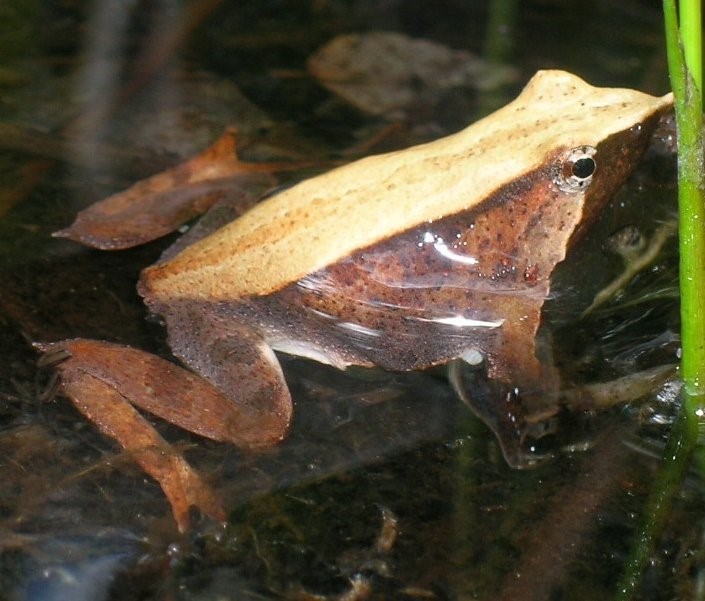 © Wikimedia.org/Mono Andes, CC BY-SA
© Wikimedia.org/Mono Andes, CC BY-SA
The desert rain frog, web-footed rain frog, or Boulenger's short-headed frog (Breviceps macrops) is a species of frog in the family Brevicipitidae. It is found in Namibia and South Africa. Its natural habitat is the narrow strip of sandy shores between the sea and the sand dunes. It is threatened by habitat loss by such factors as mining and tourism. (Source: Wikipedia.org, CC BY-SA)
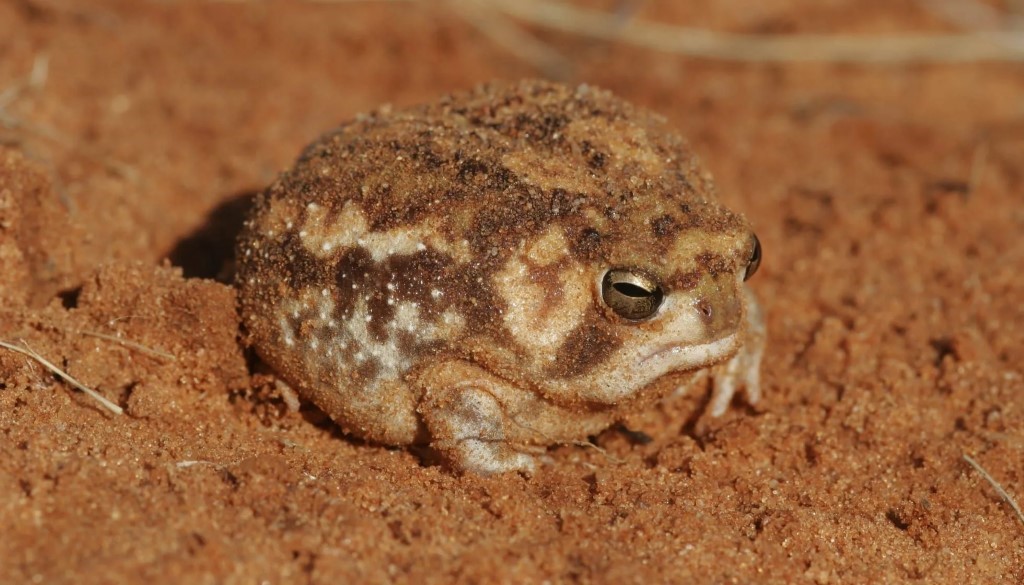 © Wikimedia.org/Marius Burger, CC0
© Wikimedia.org/Marius Burger, CC0
The edible frog (Pelophylax kl. esculentus) is a species of common European frog, also known as the common water frog or green frog (however, this latter term is also used for the North American species Rana clamitans). It is used for food, particularly in France for the delicacy frog legs. Females are between 5 and 9 cm long, males between 6 and 11 cm. This widespread and common frog has many common names, including European dark-spotted frog, European black-spotted pond frog, and European black-spotted frog. (Source: Wikipedia.org, CC BY-SA)
The fire salamander (Salamandra salamandra) is a common species of salamander found in Europe. It is black with yellow spots or stripes to a varying degree; some specimens can be nearly completely black while on others the yellow is dominant. Shades of red and orange may sometimes appear, either replacing or mixing with the yellow according to subspecies. This bright coloration is highly conspicuous and acts to deter predators by honest signalling of its toxicity (aposematism) Fire salamanders can have a very long lifespan; one specimen lived for more than 50 years in Museum Koenig, a German natural history museum. (Source: Wikipedia.org, CC BY-SA)
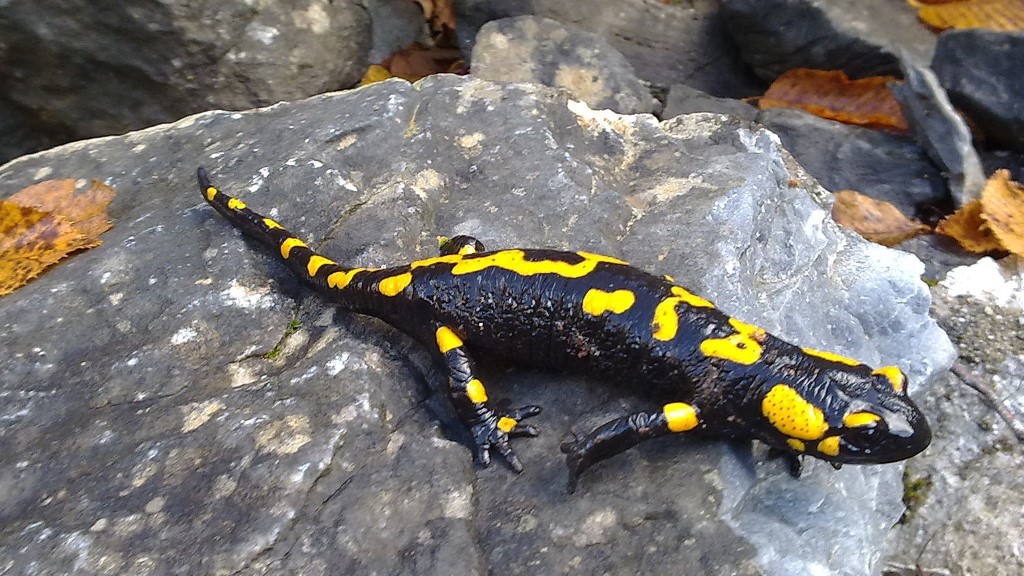 © Wikimedia.org/Cristo Vlahos, CC BY
© Wikimedia.org/Cristo Vlahos, CC BY
The fire-bellied toads are a group of six species of small frogs (most species typically no longer than 1.6 in or 4.1 cm) belonging to the genus Bombina. The name 'fire-bellied' is derived from the brightly colored red- or yellow-and-black patterns on the toads' ventral regions, which act as aposematic coloration, a warning to predators of the toads' reputedly foul taste. The other parts of the toads' skins are green or dark brown. When confronted with a potential predator, these toads commonly engage in an Unkenreflex, 'Unken-'' being the combining form of 'Unke', German for fire-bellied toad. In the Unkenreflex, the toad arches its back, raising its front and back legs to display the aposematic coloration of its ventral side. (Source: Wikipedia.org, CC BY-SA)
A frog is any member of a diverse and largely carnivorous group of short-bodied, tailless amphibians composing the order Anura (ανοὐρά, literally without tail in Ancient Greek). The oldest fossil 'proto-frog' Triadobatrachus is known from the Early Triassic of Madagascar, but molecular clock dating suggests their split from other amphibians may extend further back to the Permian, 265 million years ago. Frogs are widely distributed, ranging from the tropics to subarctic regions, but the greatest concentration of species diversity is in tropical rainforest. Frogs account for around 88% of extant amphibian species. They are also one of the five most diverse vertebrate orders. Warty frog species tend to be called toads, but the distinction between frogs and toads is informal, not from taxonomy or evolutionary history. (Source: Wikipedia.org, CC BY-SA)
The Cryptobranchidae are a family of fully aquatic salamanders commonly known as the giant salamanders. They include the largest living amphibians. The family is native to China, Japan, and the western United States. They constitute one of two living families within the Cryptobranchoidea, one of two main divisions of living salamanders, the other being the Asiatic salamanders belonging to the family Hynobiidae. (Source: Wikipedia.org, CC BY-SA)
 © Wikimedia.org/KtBstn, CC BY-SA
© Wikimedia.org/KtBstn, CC BY-SA
The glass frog belong to the amphibian family Centrolenidae (order Anura). While the general background coloration of most glass frogs is primarily lime green, the abdominal skin of some members of this family is transparent and translucent. The internal viscera, including the heart, liver, and gastrointestinal tract, are visible through the skin, giving the glass frog its common name. Their transparency becomes jeopardized once on land however, and they are considered more translucent than truly transparent. Glass frogs are arboreal, meaning they mainly live in trees, and only come out for mating season. (Source: Wikipedia.org, CC BY-SA)
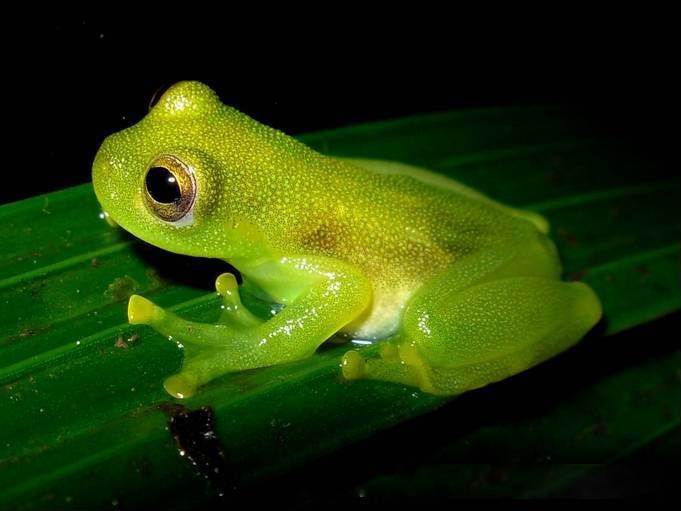 © Wikimedia.org/Mauricio Rivera Correa, CC BY-SA
© Wikimedia.org/Mauricio Rivera Correa, CC BY-SA
The goliath frog (Conraua goliath), otherwise known commonly as the giant slippery frog and the goliath bullfrog, is a species of frog in the family Conrauidae. The goliath frog is the largest living frog. Specimens can grow up to 32 centimetres (13 in) in length from snout to vent, and weigh up to 3.25 kilograms (7.2 lb). This species has a relatively small habitat range in Cameroon and Equatorial Guinea. Its numbers are dwindling due to habitat destruction and its collection for food and the pet trade. (Source: Wikipedia.org, CC BY-SA)
The gray treefrog (Dryophytes versicolor) is a species of small arboreal holarctic tree frog native to much of the eastern United States and southeastern Canada. It is sometimes referred to as the eastern gray treefrog, northern gray treefrog, common gray treefrog, or tetraploid gray treefrog to distinguish it from its more southern, genetically disparate relative, Cope's gray treefrog. (Source: Wikipedia.org, CC BY-SA)
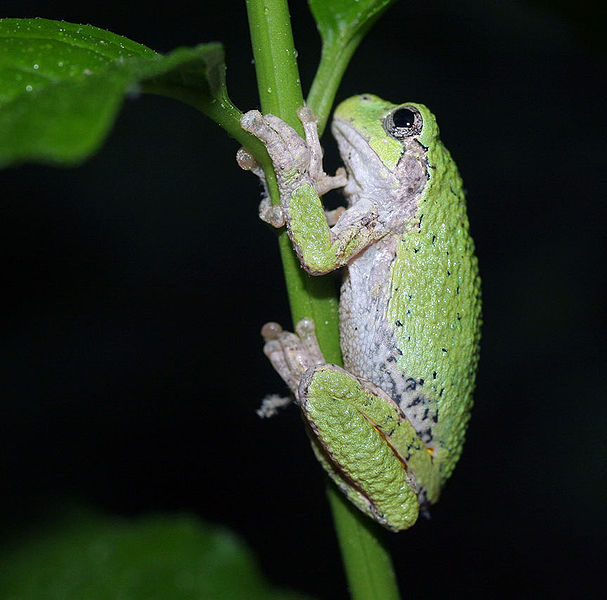 © Wikimedia.org/Robert A. Coggeshall, CC0
© Wikimedia.org/Robert A. Coggeshall, CC0
The Australian green tree frog (Ranoidea caerulea), also known as simply green tree frog in Australia, White's tree frog, or dumpy tree frog, is a species of tree frog native to Australia and New Guinea, with introduced populations in the United States and New Zealand, though the latter is believed to have died out. It is morphologically similar to some other members of its genus, particularly the magnificent tree frog (R. splendida) and the white-lipped tree frog (R. infrafrenata). (Source: Wikipedia.org, CC BY-SA)
Megophrys is a genus of frogs in the family Megophryidae. They are endemic to Indonesia, where they are found on the islands of Java and Sumatra. They commonly have elongated upper 'eyebrows' and are thus known as Indonesian horned toads. This group was thought to contain many more species and have a much wider distribution prior to recent taxonomic revisions. (Source: Wikipedia.org, CC BY-SA)
Leopard frog is a generic name used to refer to various species in the true frog genus Lithobates. They all have similar coloration: brown or green with spots that form a leopard pattern. They are distinguished by their distribution and behavioral, morphological, and genetic differences. The range of the various species of leopard frogs extends from the Hudson Bay in Canada, throughout the United States, throughout Mexico and other parts of Central America, and possibly the very northern section of South America. (Source: Wikipedia.org, CC BY-SA)
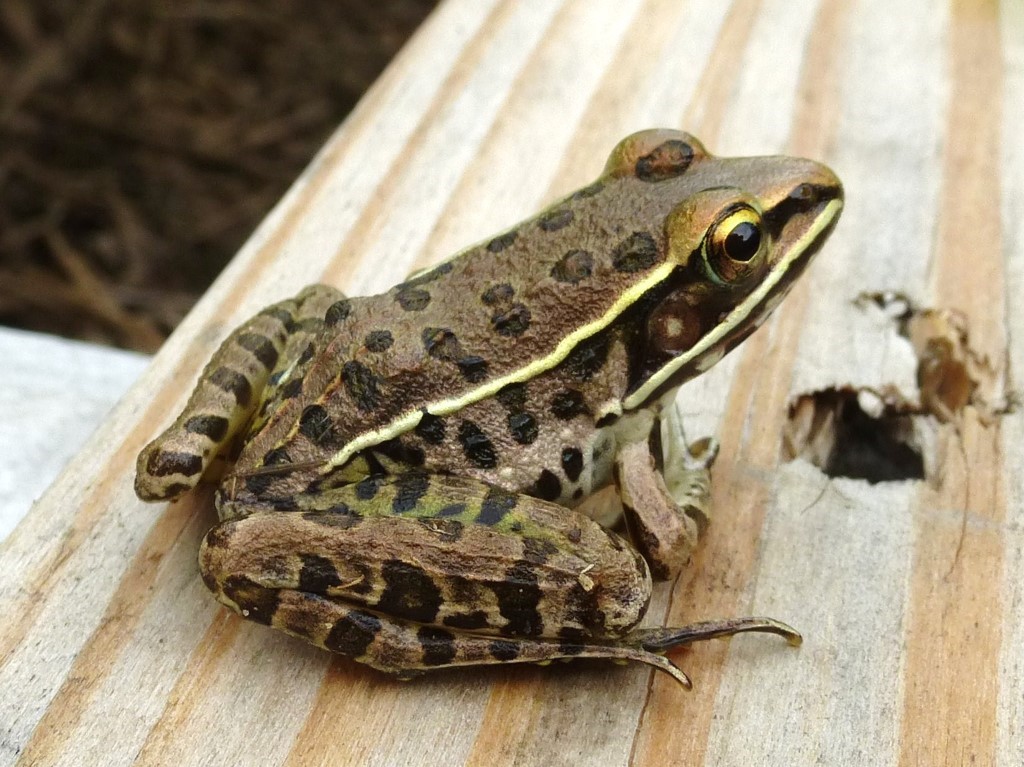 © Wikimedia.org/Bob Warrick, CC BY-SA
© Wikimedia.org/Bob Warrick, CC BY-SA
Mantella (also known as golden frogs or Malagasy poison frogs) are a prominent genus of aposematic frogs in the family Mantellidae, endemic to the island of Madagascar. The members of the genus are diurnal and terrestrial in behaviour, exhibiting bright colouration or cryptic markings which are species specific. (Source: Wikipedia.org, CC BY-SA)
The cane toad (Rhinella marina), also known as the giant neotropical toad or marine toad, is a large, terrestrial true toad native to South and mainland Central America, but which has been introduced to various islands throughout Oceania and the Caribbean, as well as Northern Australia. It is a member of the genus Rhinella, which includes many true toad species found throughout Central and South America, but it was formerly assigned to the genus Bufo. (Source: Wikipedia.org, CC BY-SA)
The marsh frog (Pelophylax ridibundus) is a species of water frog native to Europe and parts of western Asia. The marsh frog is the largest type of frog in most of its range, with males growing to a size around 100 mm (3.9 in) SVL and females slightly larger (4 in) SVL. There is a large variation in colour and pattern, ranging from dark green to brown or grey, sometimes with some lighter green lines; a lighter line on the back is generally present. The frog will usually be darker coloured in early spring to absorb heat more efficiently. (Source: Wikipedia.org, CC BY-SA)
The Monte Iberia eleuth (Eleutherodactylus iberia), also known as the Monte Iberia dwarf frog, is a species of eleutherodactylid frog. It is critically endangered and endemic to rainforest in a small part of easternmost Cuba. It is the smallest frog in the Northern Hemisphere and the third smallest frog in the world, at about 10 mm (0.4 in) in snout–to–vent length (only a few members of the Southern Hemisphere genera Brachycephalus, Mini, Paedophryne and Stumpffia are smaller). (Source: Wikipedia.org, CC BY-SA)
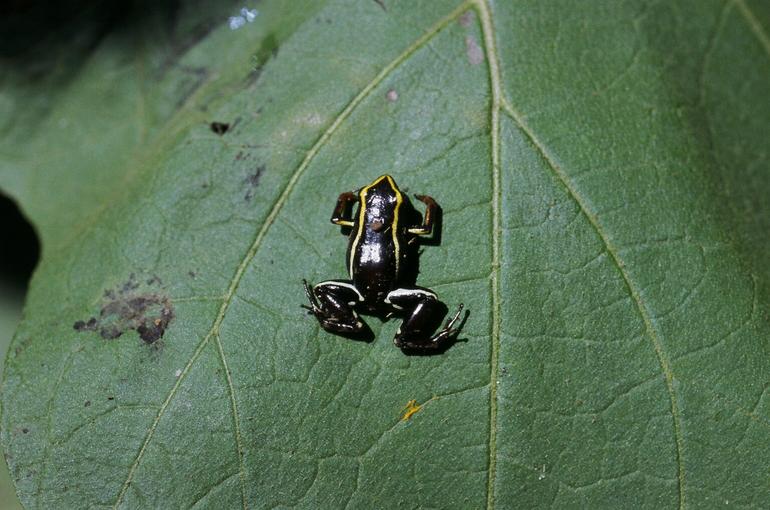 © Wikimedia.org/Pierre Fidenci, CC BY-SA
© Wikimedia.org/Pierre Fidenci, CC BY-SA
Necturus is a genus of aquatic salamanders native to the eastern United States and Canada. They are commonly known as waterdogs and mudpuppies. The common mudpuppy (N. maculosus) is probably the best-known species – as an amphibian with gill slits, it is often dissected in comparative anatomy classes. (Source: Wikipedia.org, CC BY-SA)
The natterjack toad (Epidalea calamita) is a toad native to sandy and heathland areas of Europe. Adults are 60–70 mm in length, and are distinguished from common toads by a yellow line down the middle of the back and parallel paratoid glands. They have relatively short legs, which gives them a distinctive gait, contrasting with the hopping movement of many other toad species. Natterjacks have a very loud and distinctive mating call amplified by the single vocal sac found under the chin of the male. (Source: Wikipedia.org, CC BY-SA)
A newt is a salamander in the subfamily Pleurodelinae. The terrestrial juvenile phase is called an eft. Unlike other members of the family Salamandridae, newts are semiaquatic, alternating between aquatic and terrestrial habitats. Not all aquatic salamanders are considered newts, however. More than 100 known species of newts are found in North America, Europe, North Africa and Asia. Newts metamorphose through three distinct developmental life stages: aquatic larva, terrestrial juvenile (eft), and adult. Adult newts have lizard-like bodies and return to the water every year to breed, otherwise living in humid, cover-rich land habitats. (Source: Wikipedia.org, CC BY-SA)
The oak toad (Anaxyrus quercicus) is a species of toad in the family Bufonidae. It is endemic to the coastal regions of southeastern United States. It is regarded as the smallest species of toad in North America, with a length of 19 to 33 mm (0.75 to 1.30 in). The oak toad can be identified by its light mid-dorsal stripe, variable brown and black spots, and proportionally large parotoid glands. One of the most remarkable features of this species is its small adult size relative to other toads. (Source: Wikipedia.org, CC BY-SA)
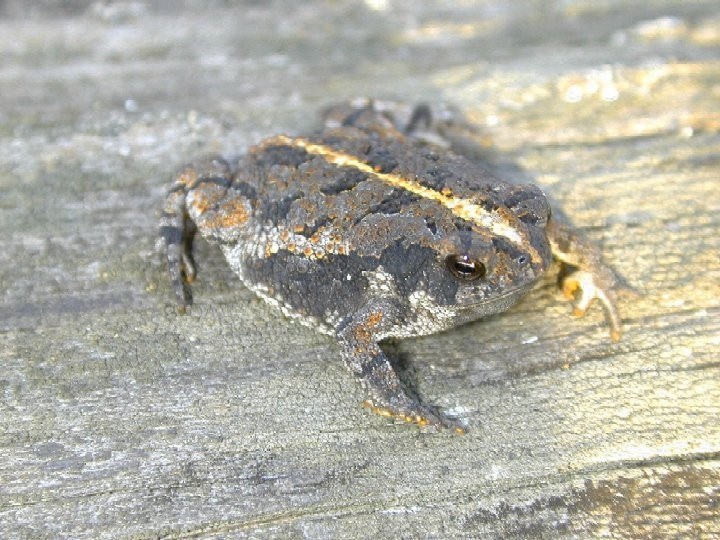 © Wikimedia.org, CC0
© Wikimedia.org, CC0
The olm or proteus (Proteus anguinus) is an aquatic salamander in the family Proteidae, the only exclusively cave-dwelling chordate species found in Europe. In contrast to most amphibians, it is entirely aquatic, eating, sleeping, and breeding underwater. Living in caves found in the Dinaric Alps, it is endemic to the waters that flow underground through the extensive limestone bedrock of the karst of Central and Southeastern Europe in the basin of the Soča River (Italian: Isonzo) near Trieste, Italy, southwestern Croatia, and Bosnia and Herzegovina. Introduced populations are found near Vicenza, Italy, and Kranj, Slovenia. (Source: Wikipedia.org, CC BY-SA)
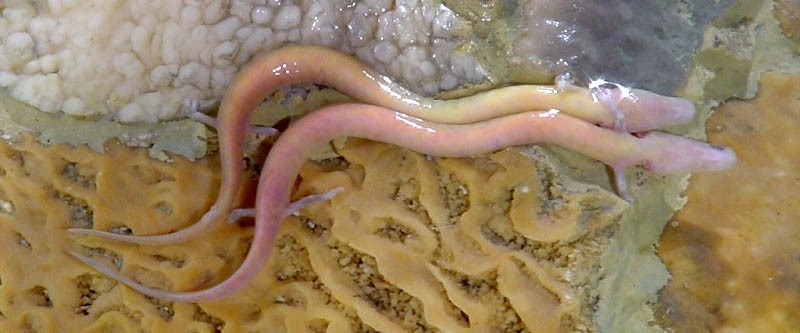 © Wikimedia.org/Boštjan Burger, CC0
© Wikimedia.org/Boštjan Burger, CC0
Poison dart frog (also known as dart-poison frog, poison frog or formerly known as poison arrow frog) is the common name of a group of frogs in the family Dendrobatidae which are native to tropical Central and South America. These species are diurnal and often have brightly colored bodies. This bright coloration is correlated with the toxicity of the species, making them aposematic. Some species of the family Dendrobatidae exhibit extremely bright coloration along with high toxicity, while others have cryptic coloration with minimal to no amount of observed toxicity. The species that have great toxicity derive this feature from their diet of ants, mites and termites. However, other species that exhibit cryptic coloration, and low to no amounts of toxicity, eat a much larger variety of prey. Many species of this family are threatened due to human infrastructure encroaching on their habitats. (Source: Wikipedia.org, CC BY-SA)
The pool frog is a small frog which rarely grows to more than 8 cm long, although females can grow up to 9 cm. Males are typically around 5 cm long, while females are around 6–6.5 cm long. These frogs are brown or green, with dark blotches along their backs, a pair of ridges running from each eye and a cream or yellow stripe down the middle of the frog's back. The vocal sacs on the male are cream or even white. (Source: Wikipedia.org, CC BY-SA)
Agalychnis callidryas, commonly known as the red-eyed tree frog, is a species of frog in the subfamily Phyllomedusinae. It is native to forests from Central America to north-western South America. This species is known for its bright coloration, namely its vibrant green body with blue and yellow stripes on the side. It has a white underside, brightly red and orange colored feet, and is named after its distinctive bright red eyes. (Source: Wikipedia.org, CC BY-SA)
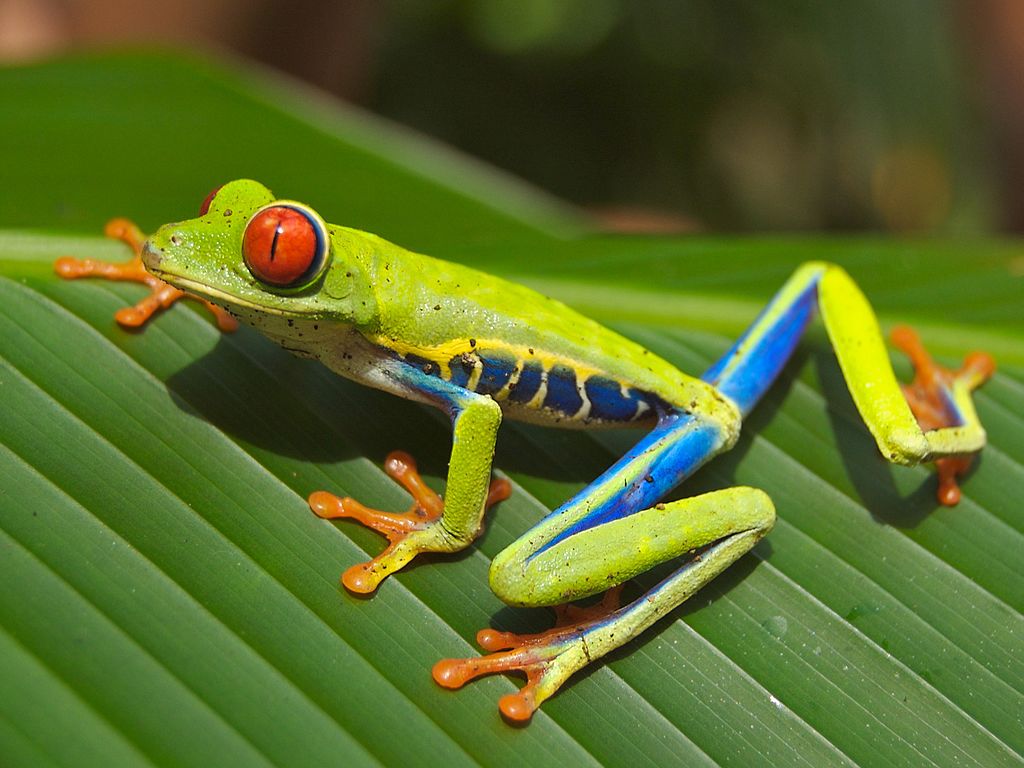 © Wikimedia.org/Carey James Balboa, CC0
© Wikimedia.org/Carey James Balboa, CC0
Salamanders are a group of amphibians typically characterized by their lizard-like appearance, with slender bodies, blunt snouts, short limbs projecting at right angles to the body, and the presence of a tail in both larvae and adults. All ten extant salamander families are grouped together under the order Urodela. Salamander diversity is highest in eastern North America, especially in the Appalachian Mountains; most species are found in the Holarctic realm, with some species present in the Neotropical realm. (Source: Wikipedia.org, CC BY-SA)
Telmatobius culeus, commonly known as the Titicaca water frog, is a medium-large to very large and endangered species of frog in the family Telmatobiidae. It is entirely aquatic and only found in the Lake Titicaca basin, including rivers that flow into it and smaller connected lakes like Arapa, Lagunillas and Saracocha, in the Andean highlands of Bolivia and Peru. In reference to its excessive amounts of skin, it has jokingly been referred to as the Titicaca scrotum (water) frog. (Source: Wikipedia.org, CC BY-SA)
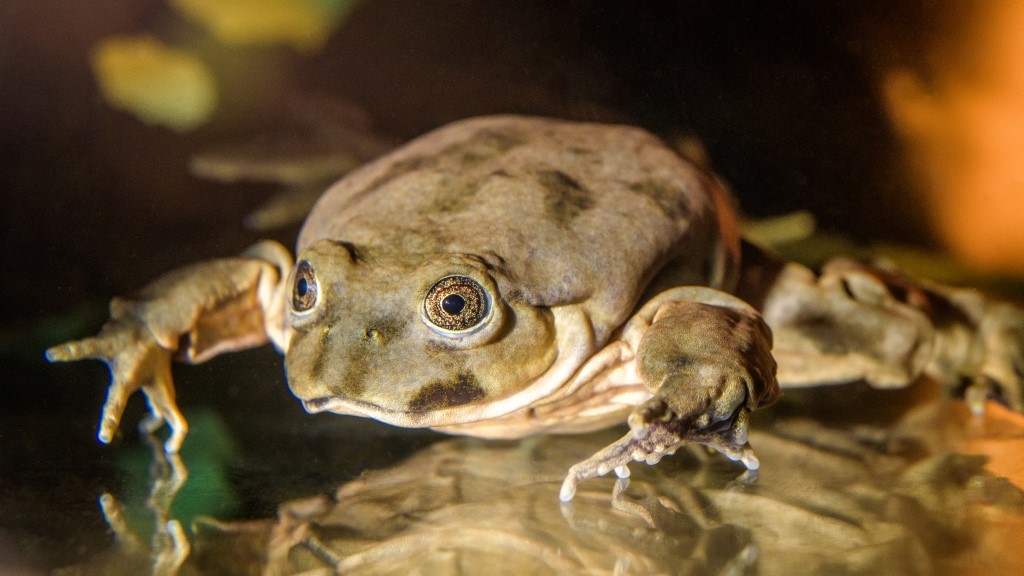 © Wikimedia.org/Petr Hamerník, CC BY-SA
© Wikimedia.org/Petr Hamerník, CC BY-SA
The Scaphiopodidae are a family of American spadefoot toads, which are native to North America. The family is small, comprising only seven different species. The American spadefoot toads are of typical shape to most fossorial (or burrowing) frogs. They are round, with short legs and protruding eyes. As suggested by their name, these frogs have hard, keratinous protrusions present on their feet, which help them to dig. Like most fossorial frogs, they dig backwards into the ground. They differ from true toads because they have vertical pupils and no parotoid gland. (Source: Wikipedia.org, CC BY-SA)
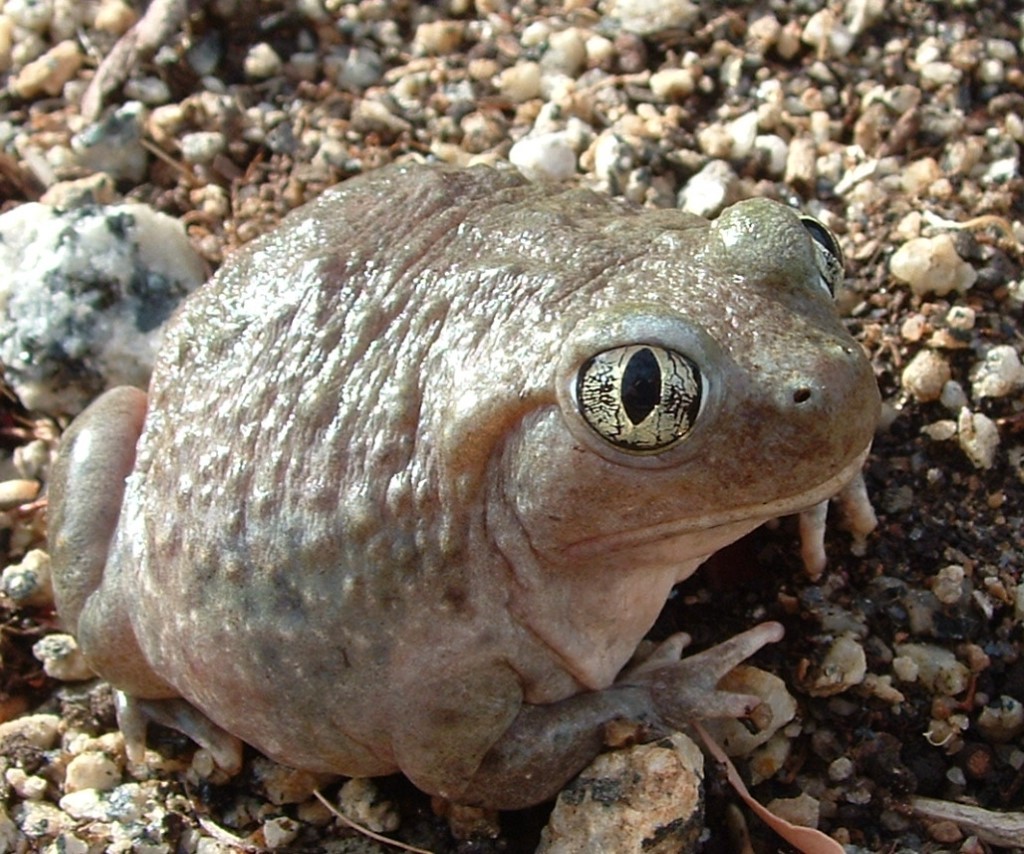 © Wikimedia.org/Sarah Beckwith, CC0
© Wikimedia.org/Sarah Beckwith, CC0
The striped rocket frog (Litoria nasuta), or in its native range known as the rocket frog, is a species of frog that occurs mostly in coastal areas from northern Western Australia to around Gosford in New South Wales at its southernmost point, with a disjunct population occurring further south at the Sydney suburb of Avalon. It also inhabits the southern lowlands and south east peninsula of Papua New Guinea. (Source: Wikipedia.org, CC BY-SA)
The tiger salamander (Ambystoma tigrinum) is a species of mole salamander and one of the largest terrestrial salamanders in North America. These salamanders usually grow to a length of 6–8 in (15–20 cm) with a lifespan of around 12–15 years. They are characterized by having markings varying in color on the back of their head, body, and tail. The coloring of these spots range from brownish yellow to greenish yellow, while the rest of their back is black or dark brown. They have short snouts, thick necks, strong legs, and lengthy tails. Their diet consists largely of small insects, snails, slugs, frogs, and worms, although it is not rare for an adult to turn cannibalistic and consume its own kind. (Source: Wikipedia.org, CC BY-SA)
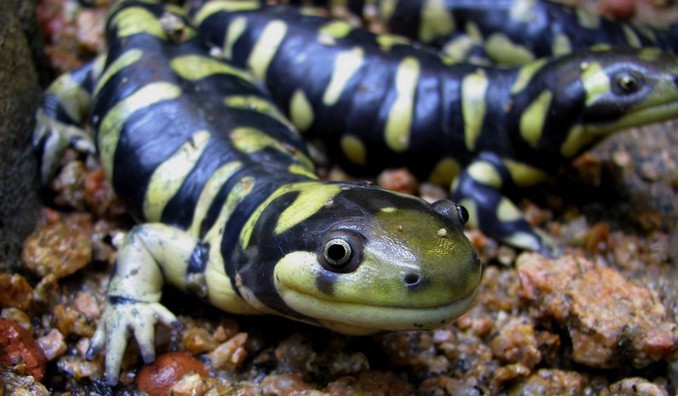 © Wikimedia.org/Carla Isabel Ribeiro, CC BY-SA
© Wikimedia.org/Carla Isabel Ribeiro, CC BY-SA
Toad is a common name for certain frogs, especially of the family Bufonidae, that are characterized by dry, leathery skin, short legs, and large bumps covering the parotoid glands. A distinction between frogs and toads is not made in scientific taxonomy, but is common in popular culture (folk taxonomy), in which toads are associated with drier, rougher skin and more terrestrial habitats. (Source: Wikipedia.org, CC BY-SA)
A tree frog (or treefrog) is any species of frog that spends a major portion of its lifespan in trees, known as an arboreal state. Several lineages of frogs among the Neobatrachia have given rise to treefrogs, although they are not closely related to each other. As the name implies, these frogs are typically found in trees or other high-growing vegetation. They do not normally descend to the ground, except to mate and spawn, though some build foam nests on leaves and rarely leave the trees at all as adults. (Source: Wikipedia.org, CC BY-SA)

Time for recess! Post a comment, ask a question or write a review. Feel free to let us know what you think!
look at the sign on the road to avoid accidents and horrible driving conditions
I received a 300$ ticket because I passed a police control of other cars/drivers on the right lane of a highway (the control was on the hard shoulder of the highway). Is it really true, that you have to change the lane in such cases? Thanks!
I am an American living in Italy. The Italian Drivers License theory test is the hardest test I have ever studied for and I am in my 70s have multiple degrees, multiple professional certifications. Have to take the Italian Drivers Theory test in Italian. No english. So many rules. More signs in small medieval Italian town I live in then in major US cities I have lived in. No Italian license no driving. No buying or renting a car. Test here was good, clean. Lots of tricky questions on many practice and real official tests. Thanks
Most problems are a result of higher than safe driving speeds. Please just slow down and be patient.
Question 121: Poor translation: Vehicles with polluted fluids prohibited Should be translated as: Vehicles with dangerous liquids prohibited
Question 83: Poor translation: Vehicles with polluted fluids prohibited Should be translated as: Vehicles with dangerous liquids prohibited
Want even more practice? Visit similar websites offering realistic practice driving knowledge tests. Visit us to see what sets our tests apart! https://dkttest.com/capital-territory/
Cool tool! And fun to check whether I remember the rules :) Two things I noticed: Warning for a crossroad side roads on the left and right. While technically that might be the correct translation, this sign tells you, that you are on the main road and have the right of way for the next crossroad and only the next crossroad. Usually (if no sign specifies otherwise) you have to give way to drivers coming from the right at every intersection, which can get a bit annoying in communal areas, so seeing this sign feels less like a warning and more like relief :). A Fahrradstraße is not a lane for cyclists but a street for cyclists, meaning the (whole!) street is intended predominantly for cyclists, who are then allowed to ride next to each other. Cars are allowed to drive there (unless another sign prohibits such), but have to adjust their speed to the cyclists. I believe they are not allowed to pass at all, even if the oncoming lane is empty.
More community